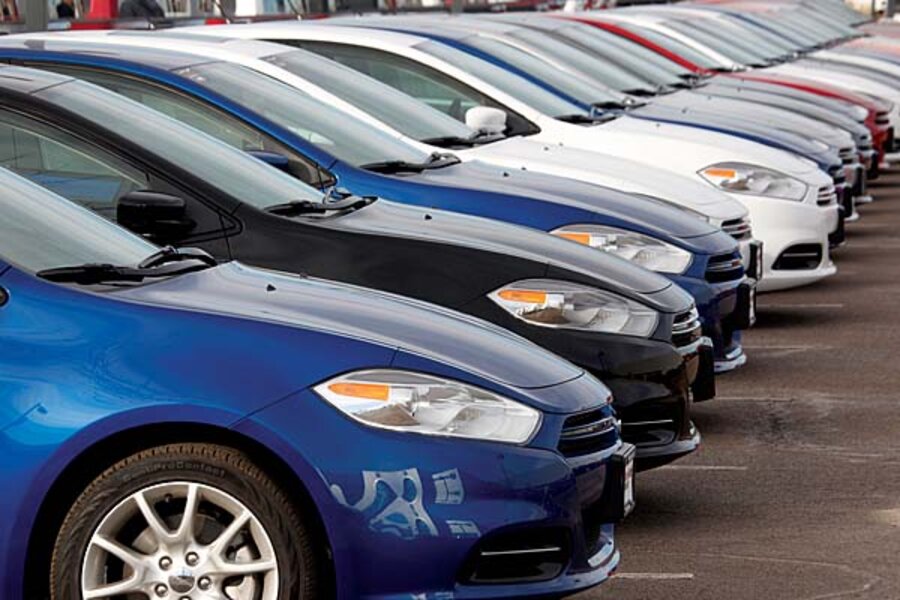Good reads: the meteors we miss, Tesla's frigid review, car-buying woes, bionic eyes
Loading...
A meteor blazed over Siberia on Feb. 15. As the rock punched through Earth’s atmosphere, it lit up the morning sky and produced a powerful shock wave. The meteor – the largest recorded space rock to hit Earth in more than a century – injured nearly 1,500 people and created a 20-foot crater near the Russian town of Chebarkul.
“Could anyone have seen the meteoroid coming?” asks Konstantin Kakaes in Slate. Probably not, at least not yet. The meteor was most likely too small for current instruments to detect. But as Mr. Kakaes writes, the National Aeronautics and Space Administration has made huge strides in locating objects before they reach our planetary backyard.
Countless chunks of rock and ice collide with Earth’s atmosphere each year. Most of them burn up on entry. NASA tracks roughly 5,000 “potentially hazardous asteroids” that measure more than 330 feet across. But the Russian rock was likely only 50 feet wide before it entered the atmosphere. Finding objects on that scale is much more difficult. “We now track nearly 100 times more PHAs than we did in 1993,” writes Kakaes, and much of those gains came from identifying small objects that were previously undetectable.
Still, space agencies have a long way to go before these fireballs are no longer a surprise. Roughly 10 meteors crash into Earth each year. Many hit unpopulated areas, such as oceans. Thousands of Cana-dians saw one in 2008. (For more on asteroids, see page 13.)
Cold shoulder for Tesla
Tesla Motors chief Elon Musk came out swinging with details he says will prove that a recent New York Times article about the Model S was “fake.” Times writer John Broder took the all-electric car for a test drive from Washington, D.C., to Connecticut. (See One Week, Feb. 25.) Tesla loaned Mr. Broder the car so he could try out the new fast-charging stations that now dot Interstate 95 and extend the range of the Model S beyond its reported 265 miles. But after a night of below-freezing temperatures, Broder says that the car battery prematurely ran out of juice, leaving him stranded beside the road and leaving many to wonder if Motor Trend’s 2013 Car of the Year can survive harsh winters.
As James Holloway writes in a play-by-play breakdown for Ars Technica, Tesla and the Times spent the next week hurling words and data at each other. After the BBC car show Top Gear showed a Tesla pooping out in the middle of a test drive in 2008, Tesla has logged the speed, battery charge, and performance of every car that it lends to journalists. The data shows that Broder routinely pulled out of Tesla fill-up stations without fully charging the battery, which Mr. Musk says is the real reason that the car petered out prematurely. Broder acknowledges that he did not top off the battery – a full charge can take more than an hour – but says he always “replenished more than enough energy for the miles I intended to drive.”
CNN ran its own test drive from Washington to Boston without incident. “However, without an overnight stop in below-freezing temperatures, this is far from a repeat of Broder’s test,” writes Mr. Holloway, “though it is arguably more representative of the way Model S owners are likely to drive the I-95.”
Protection for wily car dealers
In survey after survey, car salesperson ranks among the least trusted professions. Shoppers complain about the haggling, the seemingly manipulative sales tactics, and how difficult it is to accurately comparison shop. With 14 million vehicles sold in the United States each year, why is buying a car so awful? NPR’s Planet Money dug into the history of car dealers. Reporter Alex Bloomberg says that not only was our current system designed this way, but many local legislators want it to remain just as it is.
Practically every state has laws that protect car dealers. This legislation – mostly written back when US auto-makers had enormous power and no foreign competition – can prevent manufacturers from severing ties with problematic dealers and can carve out jurisdictions for dealerships, thereby limiting competition. While automakers have lost much of their influence over the past few decades, these laws have ensured that dealers “have become even more powerful,” Mr. Bloomberg says. “In each state, dealers contribute as much as 20 percent of sales tax revenue.” That gives lawmakers little reason to tinker with the current system.
A new aid for sight
The US Food and Drug Administration has just approved its first bionic eye. Trials show that the prosthesis, called Argus II, can restore partial sight among some blind patients.
“This enables people who are completely blind to see enough to improve their mobility,” Mark Humayun, a professor of biomedical engineering at the University of Southern California in Los Angeles, tells Technology Review. “It allows people to make out the sidewalk and stay on it without twisting an ankle, see unexpected obstacles like parked cars, make out a table, see someone coming through a doorway.”
The prosthetic eye consists of a video camera that mounts to a pair of glasses and a chip embedded near the retina. Second Sight, the California company behind the device, already sells the Argus II in Europe for roughly $100,000.







